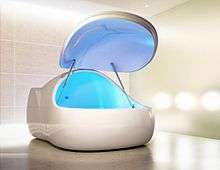Isolation tank

An isolation tank, usually called a sensory deprivation tank (also known as float tank, flotation tank, or sensory attenuation tank) is a lightless, soundproof tank filled with salt water at skin temperature, in which individuals float. They were first used in 1954 to test the effects of sensory deprivation.
History
The isolation tank was developed in 1954 by John C. Lilly, a medical practitioner and neuropsychiatrist.[1][2][3] During his training in psychoanalysis at the US National Institute of Mental Health (NIMH), Lilly experimented with sensory deprivation. After 10 years of experimentation without taking any psychoactive substances, he tried floating in combination with a psychedelic agent, mostly LSD (at that time LSD was legal in the United States).
In 1981, there were about $4 million in sales and rentals in the industry, and expectations were that the market would grow, spurred by the movie Altered States which came out in 1980.[4] According to one source in the industry, in the 1980s the rise of AIDS and the fear of shared water reduced demand for flotation centers.[5] By 2013, flotation was more popular in Europe than the US, but had undergone some growth in the area around San Francisco; at that time a low-end tank cost about $10,000 and an hour-long flotation session cost about $70.[5]
Empirical medical research
Dr. Feinstein is Director of the Float Clinic and Research Center (FCRC) at the Laureate Institute for Brain Research.
The FCRC’s mission is to investigate the effects of floatation on both the body and the brain, as well as explore its potential as a therapeutic treatment for promoting mental health and healing in patients who suffer from anxiety and PTSD.
His presentation will unveil the results from a recent float-fMRI study, illuminating for the first time how the human brain is changed by the floating experience.[6]
Notable users
Carl Lewis, track and field athlete, used in-tank visualization techniques to prepare himself for his gold medal long jump at the 1988 Seoul Olympics.[7]
Richard Feynman, Nobel Prize winning physicist, discussed his experiences with isolation tanks in Surely You're Joking, Mr. Feynman!.[8]
Two-time NBA MVP, Stephen Curry reportedly uses a sensory-deprivation tank every two weeks.[9]
See also
- Altered States, a 1980 film based on Lilly's experiments
- Dark retreat
- Prisoner's cinema
- Psychedelic experience
- Sensory deprivation
- Stranger Things
- Fringe
References
- ↑ Black, David (December 10, 1979). "Lie down in darkness". New York Magazine. 12 (48): 60. ISSN 0028-7369.
- ↑ Gelb, Michael; Sarah Miller Caldicott (2007). Innovate Like Edison. Dutton. p. 140. ISBN 0-525-95031-1.
- ↑ Lilly, John Cunningham (1996). The Scientist: A Metaphysical Autobiography (3 ed.). Ronin Publishing. p. 102. ISBN 0-914171-72-0.
- ↑ "Relaxation Tanks: A Market Develops". The New York Times. 21 November 1981.
- 1 2 Efrati, Amir. "Float Centers Gaining Steam". The Wall Street Journal. Retrieved May 15, 2013.
- ↑ "THE FEINSTEIN LABORATORY".
- ↑ "Flotation Tanks, Three Powerful Healing Therapies in One!". CNN iReport. Retrieved 2016-09-23.
- ↑ Cole, K.C. (January 27, 1985). "Book Review: Surely you're joking Mr Feynman". The New York Times:.
- ↑ Alipour, Sam (8 December 2015). "Stephen Curry on copying the Warriors' way: 'You won't have the personnel'". ESPN. Retrieved 13 December 2016.
| Wikimedia Commons has media related to Isolation tank. |